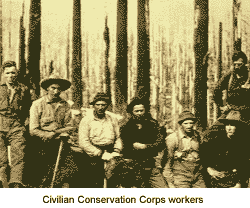Si buscas
hosting web,
dominios web,
correos empresariales o
crear páginas web gratis,
ingresa a
PaginaMX
Por otro lado, si buscas crear códigos qr online ingresa al Creador de Códigos QR más potente que existe


|
Civilian Conservation Corps Preserving America's NaturalResources: 1933-1942
The CCC, also known as Roosevelt's Tree Army, was credited with renewing the nation's decimated forests by planting an estimated three billion trees from 1933 to 1942. This was crucial, especially in states affected by the Dust Bowl, where reforestation was necessary to break the wind, hold water in the soil, and hold the soil in place. So far reaching was the CCC's reforestation program that it was responsible for more than half the reforestation, public and private, accomplish in the nation's history.
Eligibility requirements for the CCC carried several simple stipulations. Congress required U.S. citizenship only. Other standards were set by the ECW. Sound physical fitness was mandatory because of the hard physical labor required. Men had to be unemployed, unmarried, and between the ages of 18 and 26, although the rules were eventually relaxed for war veterans. Enlistment was for a duration of six months, although many reenlisted after their alloted time was up. Problems were confronted quickly. The bulk of the nation's young and unemployed youth were concentrated in the East, while most of the work projects were in the western parts of the country. The War Department mobilized the nation's transportation system to move thousands of enrollees from induction centers to work camps. The Agriculture and Interior departments were responsible for planning and organizing work to be performed in every state. The Department of Labor was responsible for the selection and enrollment of applicants. The National Director of the ECW was Robert Fechner, a union vice president chosen personally by President Roosevelt.
Young men flocked to enroll. Many politicians believed that the CCC was largely responsible for a 55 percent reduction in crimes committed by the young men of that day. Men were paid $30 a month, with mandatory $25 allotment checks sent to families of the men, which made life a little easier for people at home. Segregation and education Although policy prohibited discrimination, blacks and other minorities encountered numerous difficulties in the CCC. In the early years of the program, some camps were integrated. By 1935, however, there was, in the words of CCC director Fechner, a "complete segregation of colored and white enrollees," but "segregation is not discrimination." At its peak, more than 250,000 African Americans were enrolled in nearly 150 all-black CCC companies. An important modification became necessary early in 1933. It extended enlistment coverage to about 14,000 American Indians whose economic circumstances were deplorable and had mostly been ignored. Before the CCC was terminated, more than 80,000 Native Americans were paid to help reclaim the land that had once been theirs. In addition, in May 1933, the president authorized the enrollment of about 25,000 veterans of the Spanish American War and World War I, with no age or marital restrictions. This made it possible for more than 250,000 veterans to rebuild lives disrupted by earlier service to their country.
In June 1933, the ECW decided that men in CCC camps could be given the opportunity of vocational training and additional education. Educational programs were developed that varied considerably from camp to camp, both in efficiency and results. More than 90 percent of all enrollees participated in some facet of the educational program. Throughout the CCC, more than 40,000 illiterate men were taught to read and write. Leaving its mark on the land By 1942, there was hardly a state that could not boast of permanent projects left as markers by the CCC. The CCC worked on improving millions of acres of federal and state lands, as well as parks. New roads were built, telephone lines strung, and trees planted. The end of the CCC, the beginning of war There were numerous reasons why Congress refused to establish the Civilian Conservation Corps as a permanent agency. However, disenchantment, or failure to recognize the organization's success, were never topics of debate. In fact, Congress extended its life as an independent, funded agency for two years. The year 1939 brought about a major challenge, because there was a struggle with internal problems brought on by changing conditions in both the United States and Europe. The potential of war in Europe was belatedly recognized. Storm clouds were forming that positively affected the United States economy. The president's Lend-Lease program made jobs more plentiful in the armaments industry, and applications for the CCC declined. Also in 1939, Congress authorized the Federal Security Agency (FSA) to consolidate several offices under one director. The CCC lost its status as an independent agency. Congress added $50 million to the CCC's 1940-41 appropriation and the Corps remained at its current strength of about 300,000 enrollees. However, by late summer 1941, it was obvious that the Corps was in serious trouble. A lack of applicants, desertion, and a great number of enrollees leaving for jobs had reduced the Corps to fewer than 200,000 men in about 900 camps. Many were beginning to question the necessity of retaining the CCC when unemployment had all but disappeared. 1-The purpose of the legislation was try to help the young men. 2-The FDR who help millions of young men at the age of 18 to 21. 3- the progran was effective for a short time because they put like a temporary program. 4-3 millions of young men served in by the program. |
CREATE
|
|
CREAtE by Lisaury Pichardo |
04604




Add a comment